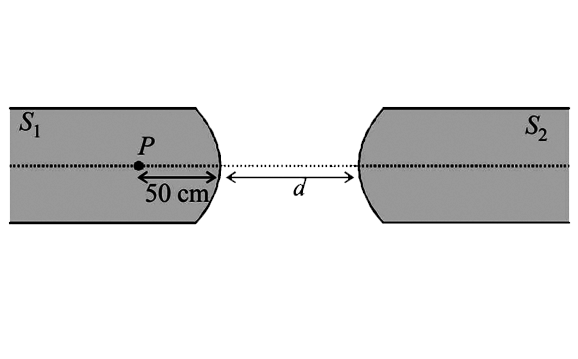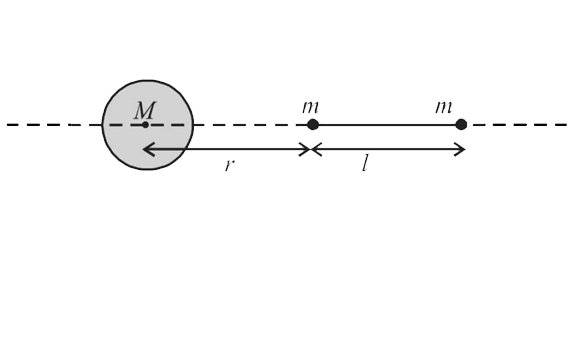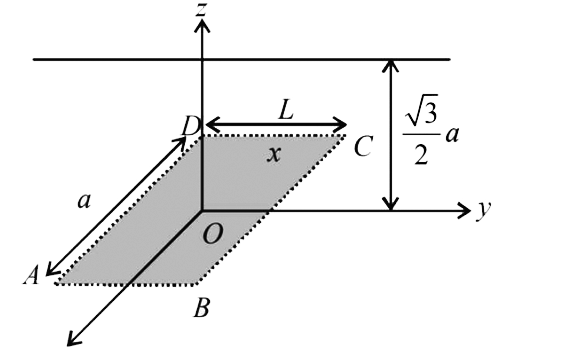Two identical glass rods and (refractive index=1.5) have one convex end of radius of curvature 10 cm. They are placed with the curved surfaces at a distance d as shown in the figure, with their axes (shown by the dashed line) aligned. When a point source of light P is placed inside rod on its axis at a distance of 50 cm from the curved face, the light rays emenating from it are found to be parallel to the axis inside . The distance d is

60 cm
70 cm
80 cm
90 cm
The correct Answer is:B
Step by step video & image solution for Two identical glass rods S_(1) and S_(2) (refractive index=1.5) have one convex end of radius of curvature 10 cm. They are placed with the curved surfaces at a distance d as shown in the figure, with their axes (shown by the dashed line) aligned. When a point source of light P is placed inside rod S_(1) on its axis at a distance of 50 cm from the curved face, the light rays emenating from it are found to be parallel to the axis inside S_(2). The distance d is by Physics experts to help you in doubts & scoring excellent marks in Class 12 exams.
Topper's Solved these Questions
- BOOK - JEE ADVANCED PREVIOUS YEARCHAPTER - JEE ADVANCEDEXERCISE - SECTION -18videos
JEE ADVANCED
- BOOK - JEE ADVANCED PREVIOUS YEARCHAPTER - JEE ADVANCEDEXERCISE - SECTION -212videos
JEE ADVANCED
- BOOK - JEE ADVANCED PREVIOUS YEARCHAPTER - JEE ADVANCEDEXERCISE - Section-18videos
JEE ADVANCED
- BOOK - JEE ADVANCED PREVIOUS YEARCHAPTER - JEE (ADVANCE) 2020EXERCISE - SECTION 36videos
JEE (ADVANCE) 2020
- BOOK - JEE ADVANCED PREVIOUS YEARCHAPTER - JEE ADVANCED 2020EXERCISE - SECTION-36videos
JEE ADVANCED 2020
Similar Questions
A larger spherical mass M is fixed at one position and two identical point masses m are kept on a line passing through the centre of M. The point masses are connected by rigid massless rod of length l and this assembly is free to move along the line connecting them. All three masses interact only throght their mutual gravitational interaction. When the point mass nearer to M is at a distance r =3l form M, the tensin in the rod is zero for m=k(M288). The value of k is
 03:10View Solution
03:10View SolutionTwo spheres P and Q of equal radii have densities ρ1 and ρ2, respectively. The spheres are connected by a massless string and placed in liquids L1 and L2 of densities σ1 and σ2 and viscosities η1 and η2, respectively. They float in equilibrium with the sphere P in L1 and sphere Q in L2 and the string being taut(see figure). If sphere P alone in L2 has terminal velocity →Vp and Q alone in L1 has terminal velocity →VQ, then
 02:22View Solution
02:22View SolutionAn infinity long uniform line charge distribution of charge per unit length λ lies parallel to the y-axis in the y−z plane at z=√32 a(see figure). If the magnitude of the flux of the electric field through the rectangular surface ABCD lying in the x−y plane with its centre at the origin is λL≠ψlon0 (ε0= permittivity of free space), then the value of n is
 04:25View Solution
04:25View SolutionA spherical bubbles inside water has radius R . Take the pressuere in the bubbled and the water pressure to be pv. The bubble now gets compressed radially in an adiabatic manner so that its raduis becomes (R - a) . For a<<R the magnitude of the work done in the process is given by (4πpoRa2)X. where X is a a constant and y=Cp/Cv=41/30. The value of X is
07:03View SolutionPut a unifrom meter scale horizontally on your extended index fingers with the left one at 0.0 cm and the right one at 90.00 cm when you attempt to move both the fingers slowly towards the center , initially only the left finger slips with respect to to the scale and the right finger does not . after some distance, the left finger stops and the right one starts slipping . Then the right finger stops at a distance XR from the center (50.00 cm ) of the scale and the left one starts slopping again . This happens because to the difference in the fiictional forces on the two fingers . it the coefficients of static and dynamic between the fingers and the scale are 0.4 and 0.32 respectively , the value of XR (in cm is ...........
03:18View SolutionTwo identical glass rods S1 and S2 (refractive index=1.5) have one convex end of radius of curvature 10 cm. They are placed with the curved surfaces at a distance d as shown in the figure, with their axes (shown by the dashed line) aligned. When a point source of light P is placed inside rod S1 on its axis at a distance of 50 cm from the curved face, the light rays emenating from it are found to be parallel to the axis inside S2. The distance d is
 02:42View Solution
02:42View SolutionWhere should a convex lens of focal lensth 9cm be placed (in cm) between two point sources S_(1) and S_(2) where are 24 cm apart, so that images of both the sources are formed at the same place. You have to find distance of lens from S_(1) or S_(2) whichever is lesser.
02:47View SolutionStatement I: Two point coherent sources of light S_(1) and S_(2) are placed on a line as shown in figure. P and Q are two points on that line. If at point P maximum intensity is observed, then maximum intensity should also be observed at Q. Statement II: In figure the distance |S_(1) P - S_(2) P| is equal to distance |S_(1) Q - S_(2) Q| .
View Solutionदो समरूप काँच की छड़े S1 तथा S2 (अपवर्तनांक = 1.5 ) जिनके एक छोर उत्तल है | जिनकी वक्रता त्रिज्या 10 सेमी है | इनके वक्र पृष्ठ एक दूसरे से d दूरी पर दर्शाये चित्रानुसार रखें है तथा उनकी अक्षे एक रेखा (बिन्दुदार रेखा द्वारा दिखायी गई ) पर है | यदि प्रकाश के एक बिन्दु स्त्रोत P को छड़ S1 कि भीतर वक्र पृष्ठ से 50 सेमी की दूरी पर रखने पर इससे निकलने वाली प्रकाश की किरणे छड़ S2 कि भीतर अक्ष के समांतर हो, तब दूरी d होगी :
 02:09View Solution
02:09View SolutionA luminous point object is placed at a distance of 20 cm, from the pole of a convex spherical surface of glass. The radius of the curvature of the convex surface is 25 cm and the R.I. of the glass is 1.5. What is the distance of the image from its pole ?
View SolutionAn image is formed at a distance of 100 cm from the glass surface with refractive index 1.5, when a point object is placed in the air at a distance of 100 cm from the glass surface. The radius of curvature is of the surface is
04:25View Solutionकिसी उत्तल लेन्स के प्रत्येक वक्र तल की वक्रता त्रिज्या 40 सेमी है तथा इसका अपवर्तनांक 1.5 है, इसकी फोकस दूरी है
02:35View SolutionTwo coherent point sources S1 and S2 are separated by a small distance 'd' as shown. The fringes obtained on the screen will be :
05:10View SolutionIf radius of curvature of curved surface of plano-convex lens of refractive index 1.5 is 60 cm, then its focal length is ...... cm.
01:59View SolutionOne end of a cylindrical glass rod (mu = 1.5) is given the shape of a concave refracting surface of radius 10cm. An air bubble is situated in the glass rod at a point on its axis such that it appears to be at distance 10 cm from the surface and inside glass when seen from the other medium. Find the actual location of air bubble.
View SolutionWhere should a convex lens of focal length 9cm be placed (in cm) between two point sources S1 and S2 where are 24 cm apart, so that images of both the sources are formed at the same place. You have to find distance of lens from S1 or S2 whichever is lesser.
05:29View Solution

